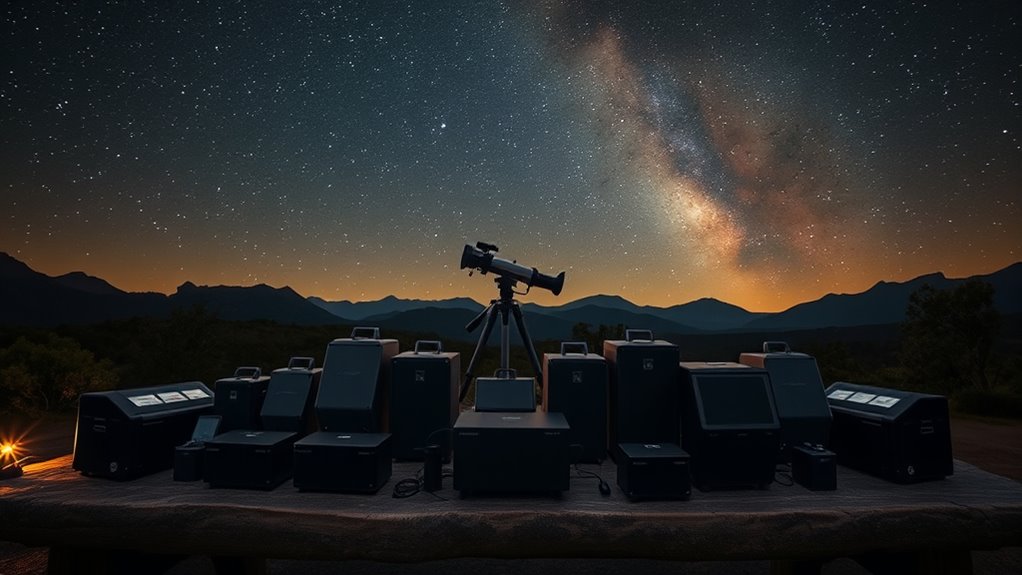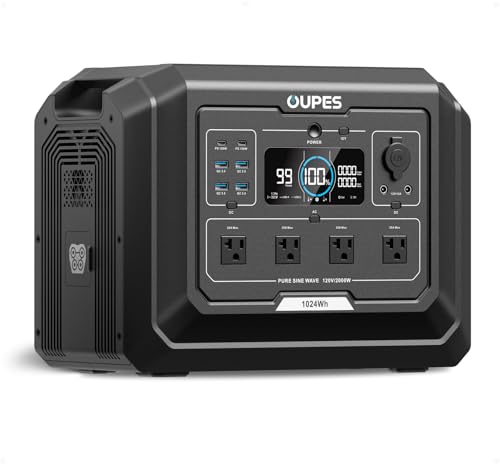If you’re looking for the best portable power stations for stargazing, I’ve found top options like the Jackery Explorer 240, EnginStar 300W, and MARBERO 88Wh, which offer reliable power for telescopes, cameras, and accessories. Larger units like the DARAN 600W and VTOMAN Jump 600X provide even more capacity and surge power. These models feature durable designs, multiple charging options, and battery technologies like LiFePO₄ for longevity. Keep exploring to find the perfect fit for your outdoor astronomy adventures.
Key Takeaways
- Look for high-capacity power stations (e.g., 500Wh+) with 300W+ output to reliably run telescopes, mounts, and cameras during extended stargazing sessions.
- Prioritize units with multiple AC, USB, and DC outlets for versatile powering of various astronomy equipment.
- Choose lightweight, portable models with durable build quality for easy outdoor transport and rugged outdoor conditions.
- Opt for units with fast recharging options and solar compatibility to minimize downtime between stargazing nights.
- Ensure the power station features advanced safety and battery management systems for reliable, safe operation in remote locations.
Jackery Explorer 240 Portable Power Station
If you’re a stargazing enthusiast looking for a reliable, portable power source, the Jackery Explorer 240 is an excellent choice. It features a 256Wh LiFePO4 battery, offering over 3,000 charge cycles and a lifespan of 10 years. Weighing just 7.7 lbs, it’s easy to carry for outdoor adventures. It provides a 300W AC outlet, USB-C port, multiple charging options, and a built-in camping light. Fast charging gets it full in 1 hour via app, 2 hours with AC, or 3 hours with solar panels. Its safety certifications and smart app control make it a versatile, dependable companion for powering lights, small appliances, or emergency devices during your stargazing trips.
Best For: outdoor enthusiasts, campers, and emergency preparedness individuals seeking a portable, reliable power source for small appliances and devices during outdoor activities or power outages.
Pros:
- Compact and lightweight design (7.7 lbs), easy to carry and transport
- Fast charging options: full recharge in 1 hour via app, 2 hours via AC, or 3 hours with solar panels
- Safe and durable LiFePO4 battery with over 3,000 charge cycles and a lifespan of 10 years
Cons:
- Limited to 300W continuous AC output, suitable mainly for small devices
- Requires adapters for certain solar panel models, adding to setup complexity
- No built-in wireless charging feature, limiting convenience for certain devices
EnginStar Portable Power Station 300W (296Wh) Battery Bank
The EnginStar Portable Power Station 300W (296Wh) stands out as an ideal choice for stargazing enthusiasts who need reliable, portable power to run their telescopes, cameras, and other equipment during outdoor sessions. Its compact design (9 x 5.5 x 7.5 inches) and lightweight build (around 7 pounds) make it easy to carry. With two AC outlets, regulated DC outputs, USB, and USB-C ports, it can power multiple devices simultaneously. The 300W continuous output and safety features like overload protection guarantee consistent performance. Support for solar, wall, and car charging offers flexible recharging options. Overall, it’s a versatile, safe, and durable power source for extended stargazing adventures.
Best For: Stargazing enthusiasts and outdoor adventurers who need a reliable, portable power solution to run telescopes, cameras, and other equipment during extended outdoor sessions.
Pros:
- Compact and lightweight design for easy portability and outdoor use
- Multiple charging options including solar, wall, and car power for versatile recharging
- Safe and durable with overload protection and high-quality lithium-ion batteries supporting over 1000 charge cycles
Cons:
- Limited continuous power output of 300W may restrict larger or high-power devices
- Slightly heavier than some portable power options at around 7 pounds
- Requires proper maintenance and careful handling to avoid overheating or early unit failure
MARBERO Portable Power Station 88Wh Lithium Battery Solar Generator
Designed for portability and reliability, the MARBERO Portable Power Station 88Wh Lithium Battery Solar Generator is an excellent choice for stargazing enthusiasts who need a compact energy source during outdoor astronomy sessions. Weighing just over 2 pounds, it’s easy to carry and fits comfortably in a backpack. It offers versatile charging options—solar, AC, and battery—so you can power your devices, like small laptops, lights, or projectors, even in remote locations. With multiple output ports, safety protections, and a built-in LED light, it’s ideal for outdoor use. Its quick recharge capability and durable design make it a dependable companion for long nights under the stars.
Best For: outdoor astronomy enthusiasts and stargazing lovers seeking a portable, reliable power source for devices during nighttime outdoor sessions.
Pros:
- Compact and lightweight design, easy to carry in backpacks or small setups
- Multiple charging options including solar, AC, and battery for versatile use in remote locations
- Built-in LED light and safety protections enhance outdoor usability and security
Cons:
- Full recharge time can be slow, especially after extensive use
- Limited capacity (88Wh) may not power larger devices or prolonged sessions
- Some users have reported malfunctions or performance issues after extended use
EHOM Portable Power Station 350W (Peak 700W) with Solar Generator and AC/USB/Car Outlets
For stargazing enthusiasts seeking reliable, portable power, the EHOM Portable Power Station 350W stands out thanks to its fast recharge capabilities and versatile outlets. Weighing just 14 pounds, it offers a 299Wh capacity and peaks at 700W, powering multiple devices simultaneously through AC, USB-A, USB-C, and car outlets. Its rapid charging via solar, AC, or car socket — reaching 80% in 55 minutes — makes it perfect for outdoor adventures. The LCD display shows essential info, while the built-in safety features guarantee stable operation. Compact and durable, this power station is ideal for camping, emergency backup, and powering small appliances during stargazing trips.
Best For: outdoor enthusiasts, campers, and emergency preparedness users seeking a reliable, portable power source with fast recharging and versatile outlets.
Pros:
- Fast recharge time of 80% in just 55 minutes via solar, AC, or car power
- Compact, lightweight design weighing only 14 pounds for easy portability
- Multiple outlets including AC, USB-A, USB-C, and car socket for versatile device compatibility
Cons:
- Limited capacity of 299Wh may not support larger or high-power appliances for extended periods
- Requires optional solar panel (not included) for solar recharging capability
- Slightly higher price point compared to basic portable power banks
DARAN Portable Power Station 600W (1200W Surge) – 288Wh Solar Generator
If you’re looking for a reliable power source to keep your astronomy gear running during outdoor stargazing sessions, the DARAN Portable Power Station 600W stands out as an excellent choice. It offers a sturdy 600W continuous output with a 1200W surge capacity, enough to power devices like mini-fridges, CPAP machines, or lights. With six ports, including AC, USB-C, and USB-A, you can charge multiple devices simultaneously. Its 288Wh battery, combined with fast recharging via AC or solar, guarantees long-lasting power. Compact and lightweight at under 14 pounds, it’s perfect for camping, RV trips, or emergency use, making it a versatile addition to your stargazing kit.
Best For: outdoor enthusiasts, campers, and emergency preparedness users needing reliable portable power for electronics and appliances during outdoor adventures or outages.
Pros:
- Powerful 600W continuous output supports a variety of high-watt devices like mini-fridges and lights
- Multiple charging ports (AC, USB-C, USB-A) allow for simultaneous device charging
- Compact, lightweight design (under 14 pounds) makes it highly portable for outdoor activities
Cons:
- Capacity of 288Wh may be limited for extended use of high-power devices
- Solar panel not included, requiring additional purchase for solar recharging
- Limited surge capacity (1200W) may not support very high-wattage appliances
Portable Power Station 300W MARBERO 237Wh Solar Generator
The MARBERO 300W 237Wh Solar Generator stands out as an excellent choice for stargazing enthusiasts who need reliable, portable power to keep their devices running during outdoor nights. Its compact size (8.15 x 5.83 x 3.90 inches) and lightweight design (4.6 lbs) make it easy to carry. With multiple outlets—including two AC ports, USB-C, and QC3.0 USB—it’s versatile for powering phones, cameras, and small gadgets. Recharging options include wall, car, and solar power. Built-in safety features and LED flashlights add convenience and security. While it’s perfect for small devices, it’s not suited for high-power appliances, but overall, it’s a practical, reliable backup for outdoor adventures.
Best For: outdoor enthusiasts, campers, and stargazing lovers seeking a lightweight, portable power source for small devices during outdoor adventures.
Pros:
- Compact and lightweight design for easy portability
- Multiple charging options including wall, car, and solar power
- Built-in safety features and LED flashlights for convenience and security
Cons:
- Not suitable for high-power appliances like refrigerators or large devices
- Slow recharging times, especially via solar or car adapter
- Occasional reports of durability issues or operational malfunctions over extended use
ALLWEI Portable Power Station 300W
The ALLWEI Portable Power Station 300W stands out as an ideal choice for stargazing enthusiasts who need reliable, quiet power on outdoor nights. With a 280Wh capacity and 300W rated output, it can power multiple devices simultaneously—phones, laptops, CPAP machines, and small appliances—thanks to its versatile ports. Its lightweight design at just 6.5 pounds makes it highly portable. Features like a silent cooling fan, LED SOS light, and durable build ensure convenience and durability. Recharging options include solar, car, or wall outlet, making it perfect for camping or emergencies. Overall, it offers dependable, noise-free power in a compact package.
Best For: outdoor enthusiasts, campers, and emergency preparedness individuals seeking reliable, quiet, portable power for multiple devices during outdoor activities or power outages.
Pros:
- Compact, lightweight design weighing only 6.5 pounds for easy portability
- Multiple versatile ports including AC, USB-C PD 60W, and DC, supporting up to 9 devices simultaneously
- Quiet operation with a silent cooling fan and durable build quality suitable for outdoor use
Cons:
- Lacks a 24V output, limiting some solar charging options
- Overload protection may shut down device if power exceeds 300W, requiring careful management
- USB port performance may vary with certain high-power devices, and battery life can decrease with frequent heavy use
OUPES Mega 1 Portable Power Station (1024Wh)
For stargazing enthusiasts who need reliable power on the go, the OUPES Mega 1 Portable Power Station offers an impressive 1024Wh capacity with expandability, making it ideal for extended nights under the stars. Its LiFePO4 battery guarantees safety and longevity, and you can expand capacity up to 5120Wh by connecting an extra B2 battery. With a 2000W continuous AC output and peaks of 4500W, it powers high-watt appliances like refrigerators and power tools. Fast charging options, multiple ports, and seamless UPS switching make this station versatile and dependable, whether you’re camping in remote areas or setting up an outdoor observatory.
Best For: outdoor enthusiasts, campers, and stargazing fans who require reliable, expandable power for extended nights and high-watt appliances in remote locations.
Pros:
- Large 1024Wh LiFePO4 battery with expandable capacity up to 5120Wh for long-lasting power.
- 2000W continuous AC output capable of running high-watt appliances like refrigerators and power tools.
- Multiple charging options including fast solar and AC charging, plus seamless UPS switching for uninterrupted power.
Cons:
- Heavier and bulkier compared to smaller portable power stations, which may affect portability.
- Higher upfront cost due to expandable capacity and advanced features.
- Limited to 13 output ports, which may be insufficient for very high device demands in some scenarios.
HOWEASY Portable Power Station, 88Wh Solar Generator
If you’re looking for a lightweight, reliable power source to keep your astronomy gear running during outdoor stargazing sessions, the HOWEASY Portable Power Station, 88Wh Solar Generator, is an excellent choice. It features a lithium battery with eight output ports, including AC sockets, USB-C, USB, QC 3.0, and DC outlets, allowing you to power multiple devices simultaneously. Its compact size (6.6 x 4 x 3 inches) and lightweight design (2.3 pounds) make it easy to carry, thanks to a hidden handle. With a built-in LED display and high-brightness LED light, it’s perfect for camping, emergencies, or powering small equipment below 150W.
Best For: outdoor enthusiasts, campers, and emergency preparedness individuals seeking a compact, reliable power source for small devices and electronics during outdoor activities or power outages.
Pros:
- Lightweight and portable at only 2.3 pounds with a hidden handle for easy carrying
- Multiple output ports including AC, USB-C, USB, QC 3.0, and DC for versatile device charging
- Built-in LED display and high-brightness LED light with multiple modes for convenience and emergency use
Cons:
- Limited capacity of 88Wh may not power larger appliances or high-wattage devices for extended periods
- Recharging options require additional equipment like a solar panel (not included) or car charger, which may add to overall cost
- Some users report faster power depletion over time, affecting long-term usage efficiency
PROGENY 300W Portable Power Station with Solar Generator and AC Outlet
With its lightweight design of just 7 pounds and a 299Wh capacity, the PROGENY 300W Portable Power Station is an ideal choice for stargazing enthusiasts who need reliable, portable power. It can charge smartphones 40 times, run laptops 4-5 times, power mini fridges for up to 18 hours, and operate CPAP machines for several nights. Multiple output options include a pure sine wave AC outlet, USB-C, QC 3.0 USB, and a car port, all supporting pass-through charging. With smart power regulation and MPPT charging via solar panels, it’s versatile and efficient for outdoor adventures, ensuring your devices stay powered during those long nights under the stars.
Best For: outdoor enthusiasts, campers, and emergency preparedness individuals seeking a lightweight, reliable power source for devices during adventures or outages.
Pros:
- Compact and lightweight at only 7 pounds, easy to carry and transport
- Multiple output options including pure sine wave AC, USB-C, QC 3.0, and car port for versatile device compatibility
- Fast recharging via solar panel, AC wall outlet, or car port with MPPT technology for efficient power management
Cons:
- Limited 299Wh capacity may not suffice for high-power or prolonged use of larger appliances
- Charging times can be longer depending on the method used, especially with lower wattage sources
- Does not have a built-in large capacity battery for extended power needs beyond small devices and short-term use
Powkey Portable Power Station 200W (146Wh) with Solar Generator Battery Pack
The Powkey Portable Power Station 200W (146Wh) stands out as an excellent choice for stargazing enthusiasts who need a reliable, portable power source to keep their devices running in remote locations. Its compact size and lightweight design make it easy to carry, while its 146Wh capacity powers smartphones, tablets, cameras, and small fans. With 7 versatile ports, including AC outlets and USB-A, you can charge multiple devices simultaneously. The pure sine wave outlets ensure stable power for sensitive electronics. Recharging options include wall outlets, solar panels, and car chargers, offering flexibility. Safety features and a simple monitoring system make it a dependable, convenient backup for outdoor astronomy adventures.
Best For: outdoor enthusiasts, camping and stargazing lovers, and anyone needing a portable, reliable power source in remote locations.
Pros:
- Compact and lightweight design for easy portability and outdoor use
- Multiple recharging options including solar, wall, and car charging for flexibility
- Pure sine wave outlets provide stable, clean power suitable for sensitive electronics
Cons:
- Limited runtime for high-wattage devices, requiring careful wattage management
- Battery capacity of 146Wh may not support longer use for larger appliances
- Manual activation needed after each full discharge, which could be inconvenient during continuous use
OUPES Exodus 1200 Portable Power Station
The OUPES Exodus 1200 Portable Power Station stands out with its impressive 992Wh capacity and 1200W rated output, making it ideal for powering essential devices during stargazing adventures. It can run a fridge for over 25 hours, charge phones 60+ times, and support high-drain appliances like microwaves or small heaters. Weighing only 23.5 pounds and compact enough to fit in trunks or backpacks, it offers 10 versatile outlets, including AC, USB-C PD, and car ports. With fast AC charging, solar compatibility, and a durable LiFePO₄ battery supporting 3,000+ cycles, it’s a reliable, versatile choice for outdoor and emergency use.
Best For: outdoor enthusiasts, emergency prepper, and homeowners seeking reliable portable power for camping, backup, or high-drain appliances.
Pros:
- High capacity (992Wh) and 1200W rated output support a wide range of devices and appliances.
- Lightweight (23.5 lbs) and compact design easily fits in backpacks or trunks for portability.
- Durable LiFePO₄ battery ensures over 3,000 charge cycles and enhanced safety features.
Cons:
- Solar charging can be slow, requiring optimal setup and patience.
- Car charging takes approximately 20 hours, which may be inconvenient in urgent situations.
- Slightly higher price point compared to basic portable power stations, though justified by features and quality.
Portable Power Station 300W with Solar Generator and Lithium Battery
A 300W portable power station with a solar generator and lithium battery offers the perfect balance of power and portability for stargazing enthusiasts. With a 230.88Wh capacity and a 330W (600W surge) pure sine wave AC outlet, it can power laptops, lights, fans, and small appliances easily. Its upgraded lithium battery with advanced BMS guarantees safety, overload, and overcharge protection. Multiple charging options—including solar, AC, and car—make recharging versatile. Built-in MPPT controller maximizes solar efficiency, ideal for outdoor adventures. Compact and lightweight, it’s perfect for camping, travel, or emergency backup during your stargazing expeditions.
Best For: outdoor enthusiasts, campers, and stargazing fans seeking a reliable, portable power source with versatile recharging options.
Pros:
- Compact and lightweight design ideal for portability during outdoor activities.
- Multiple charging options including solar, AC, and car outlet for versatile recharging.
- Built-in MPPT controller maximizes solar energy efficiency, suitable for renewable energy use.
Cons:
- Limited capacity of 230.88Wh may not support high-power appliances for extended periods.
- Maximum AC output of 330W (600W surge) might restrict the use of larger devices.
- Charging speed via USB-C PD 60W, while fast, may still be insufficient for rapid recharging during emergencies.
VTOMAN Jump 600X Portable Power Station
If you’re serious about stargazing and need reliable power on the go, the VTOMAN Jump 600X Portable Power Station is an excellent choice thanks to its robust safety features and expandable capacity. It uses SuperSafe LIFEBMS protection, safeguarding against over-charge, over-discharge, and short circuits, while the LiFePO4 battery offers safety and durability, supporting 3,000 full cycles. With an initial capacity of 299Wh, expandable to 939Wh, it delivers 600W continuous power via two AC outlets—perfect for powering water heaters or space heaters. It supports multiple device charging, including USB-C, USB-A, and DC ports, making it versatile for camping, off-grid use, or emergency backup.
Best For: outdoor enthusiasts, campers, and emergency preparedness individuals seeking a safe, reliable, and expandable portable power solution.
Pros:
- Equipped with SuperSafe LIFEBMS protection system for comprehensive safety safeguards.
- Supports expandable capacity up to 939Wh, ideal for long-term off-grid use.
- Multiple output ports including USB-C, USB-A, AC, and DC, supporting a wide range of devices.
Cons:
- Initial capacity of 299Wh may require expansion for extended power needs.
- Heavier than smaller portable power options, potentially less convenient for ultra-light backpacking.
- Limited to 600W continuous power output, which may not support higher wattage appliances.
Portable Power Station, 288Wh LiFePO4 Battery with AC Outlets
For stargazing enthusiasts who need reliable power on outdoor adventures, the portable power station with a 288Wh LiFePO4 battery and AC outlets offers an ideal solution. With a 600W rated power and surge capacity up to 1200W, it can run multiple devices simultaneously, including laptops, CPAP machines, and small appliances. Its 8 output ports support various devices, and it charges quickly via AC in just 1.7 hours or through solar panels in three hours. Lightweight at 8.7 pounds, it’s easy to carry for camping, RV trips, or emergency backup. The LiFePO4 battery guarantees safety and durability, with over 3,500 charge cycles.
Best For: outdoor enthusiasts, campers, and emergency preparedness individuals seeking reliable portable power for multiple devices in off-grid or backup scenarios.
Pros:
- Fast charging options with AC (1.7 hours) and solar (3 hours) for convenience.
- Lightweight and compact design at only 8.7 lbs, ideal for portability.
- Safe and durable LiFePO4 battery with over 3,500 charge cycles and built-in BMS.
Cons:
- Limited to a 600W rated power output, which may not support very high-power appliances.
- Solar charging depends on sunlight and an compatible panel (sold separately).
- Only two AC outlets, which may be insufficient for larger device setups.
Factors to Consider When Choosing Portable Astronomy Power Stations

When choosing a portable astronomy power station, I consider how much power I’ll need to run my equipment comfortably. I also look at how easy it is to carry, the charging options available, and whether it’s compatible with my devices. Understanding battery technology helps me pick a reliable station that lasts during those long stargazing nights.
Power Capacity Needs
Choosing the right portable astronomy power station depends heavily on evaluating your power capacity needs. First, I recommend calculating the total wattage of all devices you’ll power simultaneously to guarantee the station’s continuous wattage output matches or exceeds that total. Next, consider the capacity in watt-hours (Wh); for example, a 100Wh station can run a 50W device for about two hours. If you plan longer trips or want backup power, opt for units with 600Wh or more, supporting multiple devices for extended periods. Keep in mind that higher capacity stations tend to be bulkier and heavier, which affects portability. Finally, make sure the station can handle surge capacity to manage startup loads for devices like refrigerators or power tools, preventing shutdowns or damage.
Portability and Weight
Evaluating the portability and weight of a power station is key to ensuring it fits seamlessly into your stargazing setup. These stations typically weigh between 2 to 30 pounds, influencing how easily I can carry them into remote locations. Compact designs under 10 inches make packing into backpacks or vehicle trunks straightforward, which is essential for quick setups. Lighter models under 10 pounds are perfect for solo astronomers needing rapid deployment, while heavier units with higher capacity suit extended field research. Carrying handles, shoulder straps, and wheels boost mobility, especially for larger units on uneven terrain. Ultimately, the best choice balances weight, size, and power capacity, ensuring I can transport and set up my equipment effortlessly without sacrificing performance.
Charging Options Flexibility
Having multiple charging options is essential for ensuring my power station keeps up with my stargazing adventures. I look for stations that support AC outlets, solar panels, and vehicle 12V sockets, giving me flexibility in remote locations. Fast recharge capabilities, like reaching 80% in 1-2 hours, help me minimize downtime during long sessions. Compatibility with standard solar inputs, such as MPPT controllers, and a wide voltage range (12V-24V) allow me to efficiently harness renewable energy sources. I also value the ability to charge devices simultaneously while powering my equipment, ensuring uninterrupted observation. An adjustable or multiple port setup lets me connect different gear—telescopes, cameras, smartphones—without hassle. Flexibility in charging options keeps my stargazing smooth and reliable, no matter where I am.
Device Compatibility
When selecting a portable power station for astronomy, verifying device compatibility is key to guaranteeing smooth operation. I look for units with at least 300W output to reliably power telescopes, mounts, and cameras without issues. It’s important to check that the station supports the right voltage and plug types—whether AC, DC, or USB—to match my equipment’s needs. I also prioritize models with pass-through charging, so I can run my devices while recharging the station. Adjustable or regulated outlets, like USB-C PD or 12V DC ports, help protect sensitive gear from power fluctuations. Ultimately, I consider battery capacity and cycle life, especially with LiFePO4 chemistry, to ensure the power station can sustain long observation sessions without frequent recharges. Compatibility is essential for uninterrupted stargazing.
Battery Technology Type
Choosing the right battery technology is essential because it directly affects the safety, lifespan, and performance of your portable power station. Lithium iron phosphate (LiFePO4) batteries typically last over 3,000 charge cycles, making them more durable and reliable over time. They are also thermally stable and less prone to overheating or thermal runaway, enhancing safety during use. In contrast, lithium-ion batteries have a higher energy density, allowing for more compact, lightweight designs—ideal for portability. Additionally, advanced battery management systems (BMS) are fundamental, as they monitor voltage, current, and temperature, ensuring safe operation regardless of battery chemistry. Overall, understanding the differences in battery technology helps you choose a power station that’s both reliable and safe for long-term astronomical adventures.
Durability and Build
A durable portable astronomy power station must be built to withstand the demands of outdoor stargazing sessions. I look for rugged, impact-resistant casings made from high-quality materials like reinforced plastic or aluminum, which can handle bumps and rough handling. A high cycle life—over 3,000 charge cycles—ensures it remains reliable over time, resisting battery degradation. Weatherproof or water-resistant seals are essential to protect internal components from rain, humidity, or dust. I also prioritize models with advanced battery management systems that prevent overheating, overcharging, and short circuits, boosting longevity. Additionally, sturdy handles and reinforced corners make transportation easier and safer in rugged environments. Overall, a well-constructed power station can endure outdoor conditions, ensuring my gear stays powered through countless stargazing adventures.
Safety Features Included
Safety features are essential considerations because they guarantee reliable operation and protect both the device and the user during outdoor use. I prioritize power stations with Battery Management Systems (BMS), which prevent overcharging, over-discharging, short circuits, and overheating. Surge protection is also vital, especially during startup spikes, as many models can handle peak loads several times their rated wattage without damage. Built-in protections like auto shut-off and thermal regulation help prevent overheating and extend battery life during prolonged use. Certified safety standards such as UL, CE, or TÜV indicate the device has undergone rigorous safety testing. Additionally, overload warning indicators and automatic shutdown features alert me to potential issues early, adding an extra layer of security while stargazing in remote locations.
Price and Value
When selecting a portable astronomy power station, balancing cost with features guarantees you get the best value for your investment. Prices range from under $100 for basic models to over $1,500 for advanced units, so it’s vital to match features with your specific power needs. Comparing capacity (Wh), output options, recharge speed, and safety features helps confirm you’re getting good performance for the price. Cheaper models may lack fast charging or multiple ports, leading to higher long-term costs. Investing in higher-priced units with advanced battery chemistry like LiFePO4 offers better durability, longer lifespan, and reliability—often delivering better overall value. Also, consider additional costs for solar compatibility, accessories, and warranties, as these influence the true worth of your investment.
Frequently Asked Questions
How Long Can These Power Stations Run a Telescope Overnight?
Most portable power stations can run a telescope overnight for about 8 to 12 hours, depending on the model and the power draw of your equipment. I’ve found that higher-capacity stations with larger batteries, like those with 150Wh or more, tend to last longer. To guarantee uninterrupted stargazing, I always check the power consumption of my telescope and choose a station with a bit of extra capacity.
Are These Stations Weather-Resistant for Outdoor Stargazing?
Yes, many portable astronomy power stations are weather-resistant, designed to withstand outdoor conditions like rain or snow. I recommend checking each model’s IP rating to verify it’s suitable for your environment. I always opt for stations with an IP65 rating or higher, so I can stargaze comfortably without worrying about moisture or dust damaging the device. Just remember to keep it protected during extreme weather for peak performance.
Can They Be Charged via Solar Panels for Continuous Use?
Yes, many of these power stations can be charged via solar panels, making continuous outdoor use possible. I love that I can set up a solar panel and keep my station charged during long stargazing nights, especially in remote locations. Just verify the solar panel’s compatibility with the station’s input requirements. This eco-friendly setup means I never run out of power, and I can enjoy uninterrupted celestial views.
What Is the Weight and Portability for Backpacking Trips?
Think of a power station as your trusty star compass—compact and ready to go. Most models weigh between 10 to 20 pounds, making them easy to pack into a backpack. I find that lightweight units with ergonomic handles are best for backpacking, ensuring I can carry all my gear comfortably. They’re designed for portability, so you won’t feel weighed down while chasing celestial wonders under the night sky.
Do They Support Multiple Device Charging Simultaneously?
Yes, most portable astronomy power stations support multiple device charging simultaneously. I love how they boast several USB ports, AC outlets, and even DC connections, making it easy to power my telescope, smartphone, and headlamps all at once. This flexibility guarantees I never run out of juice during my stargazing sessions. Just keep an eye on the total wattage to avoid overloading the station, and you’re all set for a night under the stars.
Conclusion
With over 80% of stargazing enthusiasts relying on portable power stations, having the right one can truly brighten your night sky adventures. Imagine powering your telescope for up to 12 hours straight, helping you spot distant galaxies or nebulae without a hitch. Whether you’re a casual observer or a seasoned astronomer, choosing the right station keeps your passion shining bright, ensuring every stargazing session is as awe-inspiring as the universe itself.


























